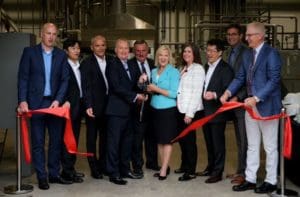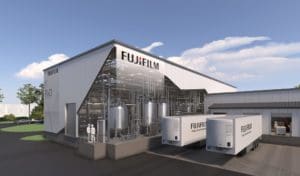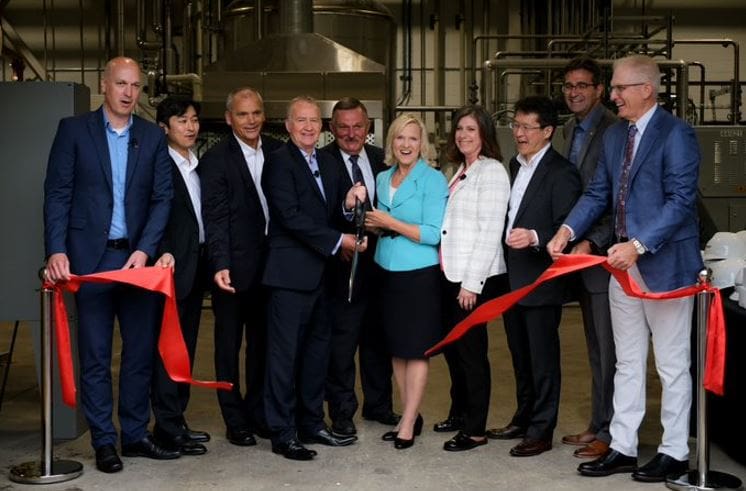

Fujifilm president Ian Wilkerson, fourth from left, and are dignitaries cut the ribbon for a new water-based ink plant.
While Fujifilm celebrated the opening of the first of its two new ink manufacturing plants in Delaware Thursday, its president said Friday it may need more.
“There might not be enough capacity,” Ian Wilkinson said. “So we need to think about what we do next.”
Its 20-acre New Castle site will be home to Fujifilm Imaging Colorants Inc.’s first dispersion ink manufacturing facility in the U.S. The $19 million investment will create more than 21 new professional, managerial, engineering and skilled labor jobs, on top of its current 90.
The jobs are rooted in the science of producing water-based digital inks, which allow printers much more flexibility in using the products. They are aimed at large commercial jobs.
Analog printing, Wilkerson said, usually requires a big order to make setting it up worthwhile. But digital inks allow companies to specialize by item.
That means a printer can put a person’s name on a single pair of new sneakers or alter food packaging to include symbols related to a specific geographic area to attract buyers in a store, he said.
While the commercial process of printing may be the same as those used in a home printer, the sizes of the machinery and quantities of ink needed are huge.
Wilkerson held up a desktop printer cartridge he’d just changed.
“You’ve got kind of five milliliters of ink inside that, maybe, and it costs you $40, $50 or something like that,” he said. “Here in this facility, our capacity for water-based inks is the equivalent of eight Olympic sized swimming pools.”
Many people over the age of 40 may think of Fuji as a film company that sold rolls of film or single-use cameras, competing with Kodak back in the day.
Now, Wilkerson said, it’s a multi-faceted company that’s largest income stream is from the medical sector.
When it became obvious in the 1990s that digital cameras were going to take over the photography business, Fuji decided to leverage its core competence of imaging and imaging technology, Wilkerson said.
In the medical sector, it sells magnetic resonance imaging machines, among other things.
Fujifilm bought into the inkjet business in 2005, Wilkerson said.
Until now, the pigments used in Fujifilm’s water-based inks were made only in Scotland and had to be shipped around the world from there. Oil-based inks are made in other places using other kinds of specialized equipment, he said.
Having plants in Delaware gives the company many advantages, Wilkerson said.
The new investment allows them to shorten supply chains and save money on freight while increasing the company’s sustainability, he said.
Fujifilm will make its own concentrate and then pump it into its own factory just feet away. That allows the company to ship more easily and quickly throughout the United States and Latin America.
“So we needed the volume because things are going very well,” he said. “But we also needed the geography.”


This Fujifilm rendering released in March shows what the New Castle facility was expected to look like.
Wilkerson said the company considered several sites for its ink facility, but settled on Delaware after finding local officials to be cooperative, pro-business and happy to be adding skilled jobs.
The 8,100-square-foot plant adds to Fujifilm’s current 40,000 square feet of occupied manufacturing space at the site, which employs 90 people.
The building now under construction will add another 11,000 square feet. It’s expected to open in March.
Like other companies, Wilkerson said that hiring has been slower than it would have been three years ago, but he expects no problems in filling the new 21 jobs.
He’s also happy to say that Fujifilm is seeing a kind of full circle moment now.
While most people stopped using cameras in favor of their smartphones early in the 2000s, some young people have stopped using phone cameras in favor of cameras that operate like Polaroids.
They take a photo and a small square of emulsion-covered paper shoots out. When the ink self-develops, there’s a photo. People are tacking them up on walls as part of decor, he said.
As this trend has been spreading in popularity, Fujifilm bought the Instax company and now is manufacturing cameras and photo film again.
“Fujifilm is always evolving,” Wilkerson said. “So even in an area that disappeared almost, it’s come back around again. It’s a more diverse company than people realize.”
Wilkerson said that the world market for ink is probably not growing, but it is changing.
One example of change, he said, is newspapers, which are losing circulation and moving to digital sites.
He believes Fujifilm is well placed because of its high quality inks and patented technology. and expects it to expand.
Wilkerson said he’s not sure the company would want to grow on its current site in New Castle, which it’s owned since 2006. Part of the property is wooded with obvious wildlife and the company wouldn’t want to lose that, he said.
In the meantime, he’d like Delawareans to be more familiar with the company.
To that end, Fujifilm has asked its team to be ambassadors for the company. They participate in public events, such as river clean-ups, and on Saturday Wilkerson is headed to the Delaware Art Museum to participate in its Beyond Juneteenth Egungun Festival, of which Fujifilm is a key sponsor.
“We want to become more active in the community, and we need people to come and work for us,” Wilkerson said. “So we’re looking for opportunities to support the community.”


Betsy Price is a Wilmington freelance writer who has 40 years of experience.
Share this Post








